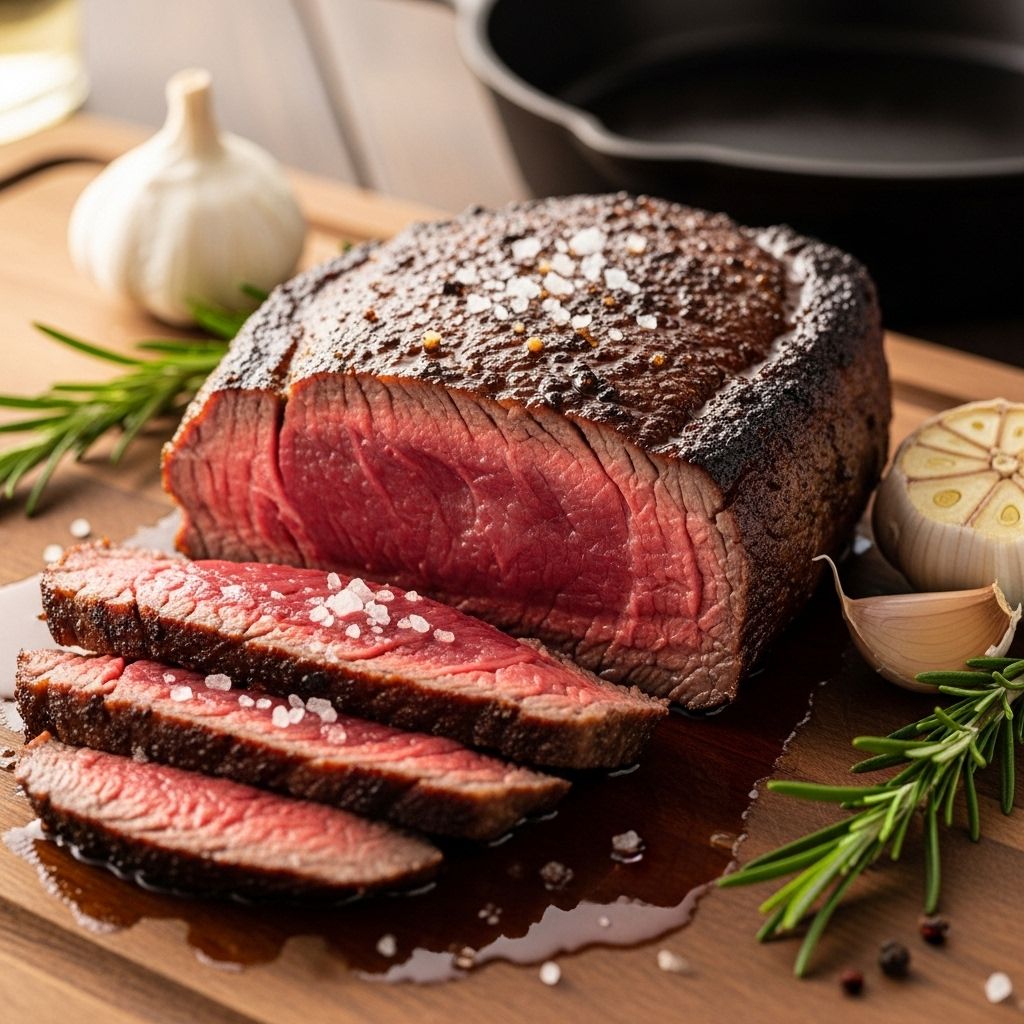Mastering Reverse-Seared Steak: The Ultimate Guide
Low-temp baking followed by a hot sear delivers a flawless crust and uniform tenderness.

Reverse-Seared Steak: The Game-Changing Technique
Reverse searing has revolutionized how home cooks and professional chefs prepare thick steaks. Unlike traditional steak-cooking methods, reverse searing delivers a consistent, edge-to-edge doneness and a deeply flavorful crust, making it the preferred method for anyone seeking steak perfection.
Why Reverse Sear?
The reverse sear method involves gently cooking steaks at a low temperature until nearly done, then quickly searing at high heat for an appetizing crust. This two-step process offers unique advantages:
- Superior Consistency: Achieves uniform doneness from edge to center, avoiding the ‘bullseye’ effect of traditional methods where the steak is overcooked near the exterior and undercooked in the center.
- Juicier Results: Gentle heat minimizes moisture loss, leading to a tender and juicy finished steak.
- Flavorful Crust: Drying the exterior during the slow cook promotes deeper browning and a rich, savory sear when finished in the skillet.
- Greater Control: Widens the window for perfect doneness, reducing the risk of overcooking and making the process more forgiving.
Kenji López-Alt and Serious Eats popularized this technique, building on the science of how heat and moisture transform meat texture and flavor.
What You’ll Need
- Thick-cut steak (1.5–2 inches preferred; ribeye, strip, Porterhouse, or T-bone)
- Kosher salt & freshly ground black pepper
- Wire rack and rimmed baking sheet
- Oven (capable of 200–275°F / 93–135°C)
- Heavy skillet (cast iron recommended)
- High-smoke-point oil (vegetable or canola)
- Butter (optional for basting)
- Instant-read thermometer
- Tongs
Step-by-Step: How to Reverse Sear Steak
1. Season and Dry
Generously season the steak all over with kosher salt and freshly ground black pepper. For best results, set steak on a wire rack in a rimmed baking sheet and refrigerate it uncovered overnight. This optional step dries the surface, promoting a fantastic crust when seared.
2. Low and Slow Oven Cooking
- Preheat oven to 200–275°F (93–135°C). Lower temperatures yield even more gradual cooking; however, cooking time will be longer.
- Place your steak — still on its wire rack — into the oven.
- Cook until the steak’s center reaches your target temperature using an instant-read thermometer:
Doneness Target Temp (Remove from oven) Approx. Oven Time Rare 105°F / 41°C ~20 min Medium-rare 115°F / 46°C ~25–30 min Medium 125°F / 52°C ~35 min Medium-well 135°F / 57°C ~40 min - Check temperature frequently; factors like steak thickness, oven accuracy, and starting temperature affect timing.
3. Sear for the Crust
- Just before the steak is ready, heat 1 tablespoon high-smoke-point oil in your skillet over high heat until smoking.
- Add the steak, and optionally a knob of butter for flavor.
- Sear each side of the steak for about 45 seconds until deeply browned.
- Use tongs to hold the steak sideways and sear the edges for uniform crust.
4. Serve — No Rest Required!
Unlike traditional methods, reverse-seared steak does not need to rest before slicing. The gentle oven cooking allows juices to redistribute as the steak slowly heats, so you can slice and serve immediately without fear of losing moisture.
Why Reverse Sear Beats Traditional Searing
- Traditional: Searing first in a hot pan creates a ‘bullseye’ — crusted exterior, steep gradient from gray to pink, narrow band of desired doneness at center. This leads to the outer layers being overcooked compared to the center.
- Reverse Sear: Slow oven heating evens out the doneness from edge to center. Searing at the end produces maximum crust without sacrificing interior tenderness. The gradient from edge to center is minimized, so nearly every bite is the perfect doneness.
Expert Tips & Variations
- Dry Brining: Salting and letting meat air-dry overnight intensifies flavor and improves crust texture.
- Oven Temperature: Lower oven temperatures enhance even doneness but require more cooking time. Use a reliable instant-read thermometer to avoid overcooking.
- Steak Thickness: This method excels with thick steaks (1.5” or more). Thin steaks (<1”) don’t benefit as much, as they cook through too quickly for low-and-slow heating.
- Pan Choice: Cast iron retains and distributes heat best for a robust sear. Stainless steel skillets also work well.
- Butter & Aromatics: After flipping, add butter, garlic, and herbs like thyme or rosemary for an aromatic baste.
- Edge Searing: Holding the steak sideways with tongs allows you to sear the fat cap and edges for full-flavor coverage.
- Serving: Slice against the grain for tenderness.
Common Mistakes to Avoid
- Skipping Thermometer: Guessing doneness is unreliable. Even pros rely on instant-read thermometers for precision.
- Using Too Much Oil: The steak should be dry for optimal browning. Excess oil can interfere with crust formation.
- Starting with Wet Steak: Pat steak dry before oven-cooking for ideal Maillard reaction during searing.
- Overcooking: Oven temperatures and steak thickness vary — monitor frequently.
Nutritional Considerations
Reverse-seared steak is rich in protein, iron, and other nutrients found in beef. The method itself does not significantly change the calorie or nutrient profile. Using moderate butter for basting adds flavor, but be mindful of added saturated fats if tracking macros or calories.
Reverse Sear vs. Sous Vide
| Reverse Sear | Sous Vide |
|---|---|
| Uses oven for low temp cooking, then finishes in skillet with high heat | Vacuum-sealed steak is cooked in water bath to exact temp, then seared |
| Simple equipment: oven, skillet, thermometer | Requires sous vide device, bags, and sometimes a torch or pan |
| Surface dries out naturally, aiding better crust | Surface stays moist; may require extra drying step before searing |
| Classic roasted and grilled steak flavors from oven and pan searing | Ultra precise doneness, especially for very thick or delicate cuts |
Frequently Asked Questions (FAQs)
Q: Can I reverse sear any steak?
A: Reverse searing works best with thick steaks, such as ribeye, strip, Porterhouse, or T-bone. Thin steaks cook too quickly for the method to have much effect.
Q: How important is dry brining?
A: Dry brining — salting and refrigerating uncovered overnight — significantly improves the crust and flavor, but you’ll still get excellent results just by seasoning before cooking.
Q: Can I use a grill instead of an oven?
A: Yes, you can mimic the reverse sear by cooking steak on the cool side of a grill with the lid closed, then finishing over direct high heat with the lid open.
Q: Why don’t I need to rest the steak after reverse searing?
A: The slow oven cooking allows juices to redistribute gradually, so the quick final sear does not force juices out as aggressive pan-searing can. You can slice and serve straight away.
Q: What is the best oil for searing?
A: Use oils with a high smoke point, such as canola, vegetable, or peanut oil, to avoid burning flavors. Butter adds flavor but should be added late in the searing process.
Q: How do I know when my steak is done?
A: Always use an instant-read thermometer, and consult the table above for target temperatures. Estimating by touch is less reliable, especially with thick cuts.
Q: Is reverse sear suitable for other meats?
A: The technique can be adapted for thick-cut pork chops, lamb chops, and some roasts, but works best for beef steaks due to their fat and flavor profile.
Conclusion
The reverse sear technique combines scientific insight with practical steps for the home cook, guaranteeing results previously reserved for steakhouses. The slow, deliberate approach transforms steak into a memorable, restaurant-quality dish with minimal effort and maximum flavor.
For steak lovers everywhere, mastering the reverse sear means every steak can be your best steak yet.
References
Read full bio of Shinta












